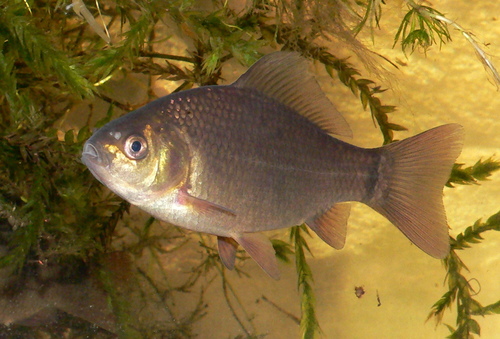
Crucian carp
The Atlantic bluefin tuna (*Thunnus thynnus*) is a majestic and highly migratory species of tuna found in the Atlantic Ocean and the Mediterranean Sea. Renowned for its size, speed, and commercial value, it plays a crucial role in the marine ecosystem and is a prized catch in fisheries worldwide.
5 10 years
Lifespan
15 - 35 cm
Length
Least Concern
Conservation Status
Omnivorous, Detritivorous
Diet
Local Migration
Migration
Appearance Overview
The Atlantic bluefin tuna is a large, torpedo-shaped fish with a metallic blue-black back and a silvery-white belly.
Coloration
Dark metallic blue on top, silvery-white underside
Fins
Two dorsal fins, the first depressible; small finlets behind second dorsal and anal fins
Body Shape
Torpedo-shaped, streamlined body built for speed
Length
Up to 13 feet (4 meters)
Weight
Up to 2,000 lbs (907 kg)
Diet
Carnivorous, feeding on smaller fish (like mackerel, herring, and hake), squid, and crustaceans.
Feeding Behavior
Highly active predator that hunts by sight and uses its speed to chase down prey. They are opportunistic feeders, sometimes feeding near the surface and other times diving to considerable depths.
Social Behavior
Forms large schools, especially when young. Adults may travel alone or in smaller groups. They exhibit complex migratory patterns.
Commercial Relevance
Extremely high value, particularly in the Japanese sushi and sashimi market, where a single fish can sell for hundreds of thousands or even millions of dollars.
Conservation measures
International fishing quotas, size limits, seasonal closures, and monitoring programs managed by organizations like ICCAT (International Commission for the Conservation of Atlantic Tunas). Efforts to reduce bycatch are also underway.
Status
Varies by population. The Western Atlantic stock is considered 'Near Threatened', while the Eastern Atlantic and Mediterranean stock is considered 'Least Concern' following some recovery.
Threats
Historical overfishing (primarily for the sushi market), bycatch in fishing gear targeting other species, and climate change affecting prey distribution and spawning grounds.
Habitat Distribution
Depth Range
0-1,000 meters (0-3,280 feet), though they are most commonly found in the upper few hundred meters.
Geographic Range
Western and Eastern Atlantic Ocean, Mediterranean Sea. Historically, also in the Black Sea (now largely absent).
Preferred Environment
Primarily pelagic (open ocean), preferring temperate and subtropical waters. They undertake extensive transoceanic migrations.
Reproduction and Life Cycle
Breeding Habits
Spawns in warm waters, with major spawning grounds in the Gulf of Mexico (western stock) and the Mediterranean Sea (eastern stock). Spawning typically occurs in spring and summer.
Development Stages
Eggs hatch into larvae that feed on plankton. Juveniles grow rapidly, forming large schools. They gradually transition to a diet of larger prey as they mature.
Fecundity
Highly fecund; a large female can produce up to 30 million eggs per spawning season.
Maturity Age
Western Atlantic stock: matures around 8-12 years. Eastern Atlantic stock: matures earlier, around 4-5 years.
Faqs about Crucian carp
Where can Atlantic bluefin tuna be found?
Atlantic bluefin tuna are found in the Atlantic Ocean, both in the western and eastern parts, and in the Mediterranean Sea.
Are bluefin tuna migratory?
They are highly migratory, traveling long distances across the ocean for feeding and spawning.
How long do Atlantic bluefin tuna live?
They can live up to 40 years, though many do not reach this age due to fishing pressure.
Are bluefin tuna warm-blooded?
Yes, they are warm-blooded, which helps them maintain high activity levels in cold water.
How fast can bluefin tuna swim?
They can swim at speeds up to 43 mph (70 km/h) in short bursts.
What adaptations allow bluefin tuna to be such fast swimmers?
Their warm-bloodedness, streamlined body, and specialized finlets help reduce drag and allow for high-speed swimming and efficient long-distance travel.
Which organizations manage bluefin tuna fisheries?
ICCAT is the primary organization responsible, setting quotas and regulations. Individual countries also implement management measures.
How many eggs do female bluefin tuna lay?
Females can release millions of eggs per spawning season, although survival rates to adulthood are low.
What is special about their body temperature regulation?
Bluefin tuna are warm-blooded (endothermic), a rare trait among fish, allowing them to maintain a higher body temperature than the surrounding water, enhancing muscle efficiency for swimming.
Copyright @ Nature Style Limited. All Rights Reserved.
 English
English